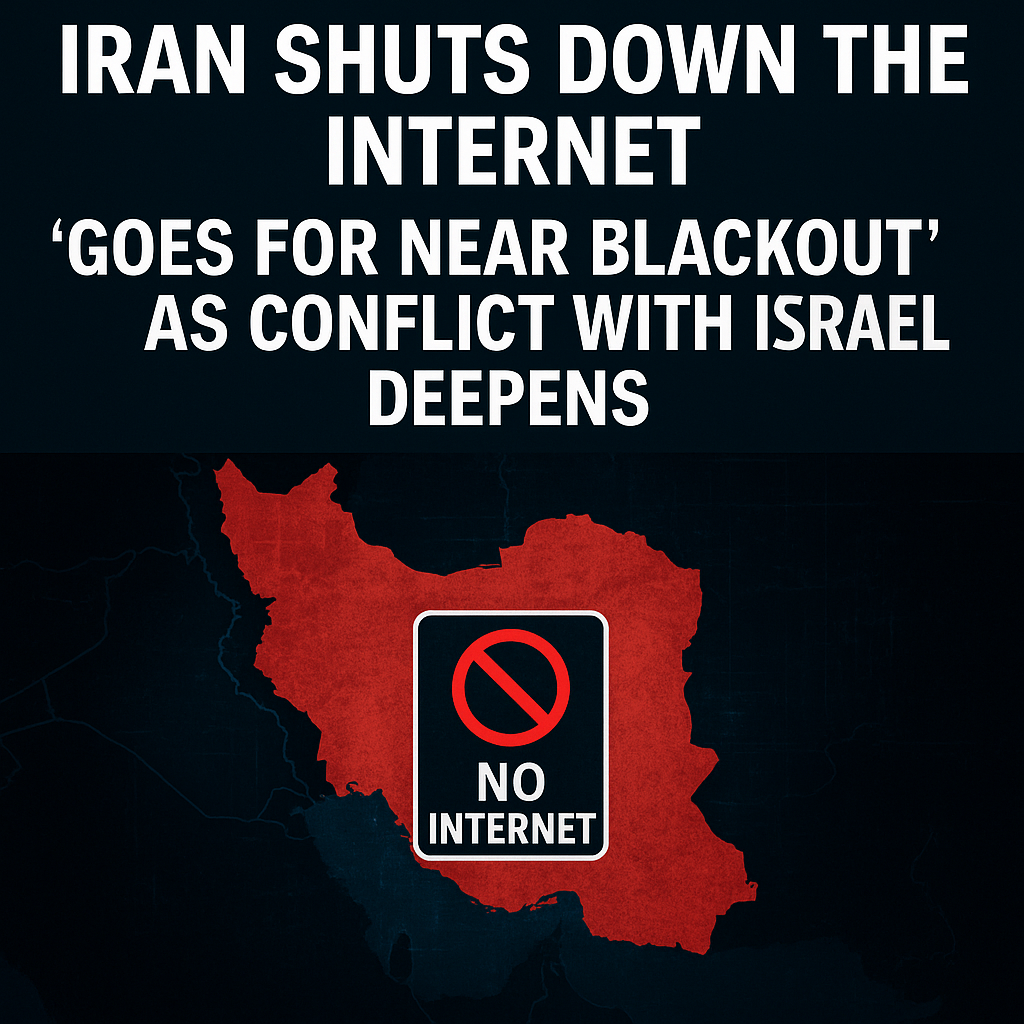Iran Shuts Down the Internet, 'Goes for Near Blackout' as Conflict with Israel Deepens
In a deeply concerning move that has alarmed international observers and digital rights groups, Iran has begun enforcing a sweeping internet shutdown across the country. As the conflict between Iran and Israel intensifies, the Iranian government has chosen to restrict access to global online platforms, effectively pushing the nation toward a near-total internet blackout. The implications of this act ripple far beyond its borders, affecting regional stability, international diplomacy, and the free flow of information in a time of growing geopolitical uncertainty.
The sudden blackout, which began late Monday night and expanded through Tuesday, has blocked users from accessing common services including Google Play, Apple’s App Store, and the widely used messaging platform WhatsApp. Iranian citizens woke up to a digital silence, unable to communicate freely, access independent news, or interact with the outside world. For many, this was reminiscent of previous clampdowns during nationwide protests, but on a scale that experts say is unprecedented in the region’s recent history.
A Nation Cut Off in Real-Time
The blackout was confirmed by multiple internet monitoring organizations, who noted an abrupt drop in traffic from Iran. Reports from inside the country have described complete service disruptions across major mobile networks, and many regions are experiencing severe limitations in even basic broadband services. Authorities have not provided an official statement explaining the reasoning, but analysts believe the move is designed to suppress any internal dissent as military tensions with Israel mount.
The ongoing situation between Iran and Israel has escalated to dangerous levels over the past weeks. Skirmishes at the border, cyberattacks attributed to both nations, and aggressive posturing in diplomatic forums have all contributed to a charged atmosphere. Analysts suggest Iran's decision to shut down the internet reflects growing insecurity within the regime about its ability to manage both external threats and potential internal uprisings.
Patterns of Censorship in Iran
This is not the first time Iran has weaponized internet infrastructure to control the population. In recent years, especially during protests over political repression, economic crises, and women’s rights, the government has repeatedly restricted internet access to silence dissent and prevent organizing. However, what distinguishes this latest blackout is its scale and timing.
According to digital watchdog NetBlocks, the disruption began shortly after Iranian state media issued statements warning about \external enemies\ attempting to destabilize the country. Many suspect this was a precursor to justify extreme measures under the guise of national security. The breadth of the current blackout, however, marks a new chapter in Iran’s digital authoritarianism. It is one thing to throttle social media during protests—it is another to shut down entire portions of the internet infrastructure during a geopolitical conflict.
Silencing the Voices of a Nation
The consequences for Iranian citizens are immediate and dire. Families have been cut off from loved ones abroad. Businesses reliant on online services are paralyzed. Students and researchers are left in the dark. Activists and journalists, many of whom rely on secure messaging platforms to communicate safely, are left vulnerable.
The psychological toll is equally heavy. In an age where connectivity is synonymous with freedom and knowledge, being digitally silenced is akin to erasing a voice. Iranians are not only experiencing a form of digital exile but are being forcibly isolated at a time when global attention and support are most needed.
The Global Response
The international community has responded with concern but little action. Statements have trickled in from human rights organizations and Western governments, calling on Iran to restore internet access and protect the rights of its citizens. The U.S. State Department condemned the move, labeling it a “violation of fundamental freedoms,” while the European Union urged Iranian authorities to ensure open communications.
But beyond statements, there has been limited practical recourse. Unlike sanctions or military measures, enforcing digital rights across borders is a complex challenge. Many experts argue that the only real deterrent to such actions is the development of decentralized technologies that can bypass government controls. Tools like satellite-based internet (such as Starlink) or peer-to-peer communication apps may offer long-term solutions, but for now, millions remain cut off.
The Bigger Picture: Internet as a Weapon of War
Iran’s decision reflects a broader global trend in which the internet is increasingly used as a tool—or weapon—by authoritarian regimes. From Myanmar to Russia, the practice of \turning off\ the internet to control narratives and suppress opposition is becoming alarmingly normalized.
In times of conflict, controlling information is as vital as controlling territory. Iran’s move is strategic: by cutting off access to outside information, the regime can shape domestic narratives, suppress unfavorable news, and manage internal morale. It can also restrict the ability of foreign journalists, researchers, and governments to verify reports of what is happening on the ground.
The Role of Tech Giants and Responsibility
Companies like Apple, Google, and Meta (which owns WhatsApp) are caught in a delicate position. On one hand, they must abide by the rules of the countries in which they operate. On the other, they face increasing pressure to resist participating in digital censorship.
There is growing demand for tech firms to invest more aggressively in circumvention tools, privacy-focused messaging platforms, and resilient communication networks. While some efforts have been made in the past, the current crisis in Iran may reignite calls for a more proactive stance from Silicon Valley.
What Happens Next?
As the blackout continues, questions remain about its duration and the Iranian government’s long-term plans. Is this a temporary measure, or the beginning of a more permanent form of digital isolation? Will this inspire citizens to protest harder once connectivity returns, or will it solidify the government’s control?
Already, underground networks are reportedly working to restore some access via VPNs, mesh networks, and other tools. However, Iran has become increasingly adept at detecting and neutralizing these efforts. In response, some activists have begun organizing offline, relying on older methods of communication to bypass surveillance.
A Test for the International Community
Ultimately, Iran’s internet shutdown is not only a national crisis but a test for the global community. It forces us to reconsider the meaning of freedom in a hyperconnected world. When a government can simply unplug its people from the global conversation, what protections remain? What obligations do tech companies and democracies have to prevent such acts? And how can we ensure that the next generation doesn’t grow up in a world where silence can be imposed with a switch?
Until these questions are answered, millions of Iranians remain in digital darkness—isolated, unheard, and at the mercy of a government that sees connection as a threat.
Conclusion: A Dangerous Precedent
The near-total internet blackout in Iran is more than a domestic policy move. It is a symbol of how modern authoritarian regimes can and will use digital tools to exert power. As the conflict with Israel deepens, the blackout serves not only as a method of control but also as a warning to others: in today’s world, access to the internet is not a guarantee—it is a privilege that can be revoked in an instant.
For Iran’s citizens, the battle now is not just against censorship, but against a system that sees their ability to speak, connect, and organize as a threat. And for the world, it is a moment to reflect on the fragility of digital freedom—and the urgent need to defend it.

















Comments 0